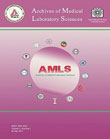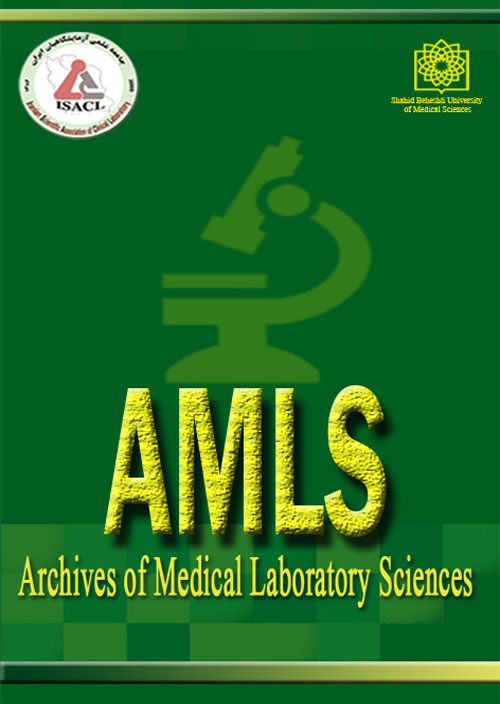فهرست مطالب

Archives of Medical Laboratory Sciences
Volume:2 Issue: 2, Spring 2016
- تاریخ انتشار: 1395/02/20
- تعداد عناوین: 5
-
-
Page 39BackgroundThe human leukocyte antigen-DRB1 (HLA-DRB1) locus is one of the most polymorphic human loci and has a crucial role in the immune system. Assessing the allelic frequencies of HLA-DRB1 locus would be a fundamental factor in defining the origin of populations, relationships with other populations, disease association studies and the constitution of unrelated bone marrow donor registries. In the current study HLA-DRB1 alleles and their frequencies are determined in a family-based study by DNA sequencing-based typing high-resolution (2 field) level of typing.Materials And MethodsGenomic DNA from 3 members of 68 unrelated families (a total of 204 individuals) was extracted. Exon 2 of DRB1 gene was amplified and sequenced and allele assignment was performed using Assign SBT v4.7sequence analysis software.ResultsWe had DRB1*11:04 with frequency of 0.0931, DRB1*03:01 with 0.0882, DRB1*11:01 with 0.0735, DRB1*13:01 with 0.071 and also alleles DRB1*08:03, DRB1*13:42, DRB1*14:04 and DRB1*14:07 with frequency of 0.0024.ConclusionA total of 34 different alleles were found in the study subjects with DRB1*11:04, DRB1*03:01, DRB1*11:01 being the most frequent alleles respectively.Keywords: Genotype, HLA-DRB1, Iran, HLA-typing
-
Page 46BackgroundBlack Seed (BS) is used in traditional medicine as a therapy for a variety of diseases including allergic asthma.Materials And MethodsIn the present study, anti-inflammatory and immunomodulatory effects of BS on cytokine gene expression, lung airway eosinophilia and goblet cell hyperplasia were examined in a mouse mice model of allergic asthma. Groups of 6-week-old female BALB/c mice were sensitized by intraperitoneal injections of OVA plus alum on days 1 and 14. On days 24, 26, 28 and 30, the mice were exposed to OVA in saline for 30 min with nebulizer. Similar experiments were conducted with mice receiving saline as a negative control.ResultsThe mouse allergic asthma model received BS by food on days 23, 25, 27 and 29. Then, the percentage of inflammatory cells as well as mRNA expression levels of interleukin (IL)-4, IL-5, IL-13 and mucin (MUC5a) genes were survived in Broncho-alveolar lavage fluid (BALF). Furthermore, we attempted to examine histopathological examination of the lung. Mice receiving BS showed a significant decrease in the number of eosinophils, and a potential inhibitory effect on mRNA expression levels of Th2-driven immune response cytokines and mucin, resulting in decreased production of interleukin and mucin in allergic asthma.ConclusionOur findings suggested that BS has an anti-inflammatory and immunomodulatory effect during the allergic response in the lung, and can be a promising treatment for allergic asthma in humans.Keywords: Black Seed, allergic asthma, Th2-type cytokines mRNA, mucin
-
Page 54BackgroundRecently, much attention has been directed towards considering activated microgelial cells as putative targets for treatment of neurological disorders. MigriHeal® as a novel herbal remedy was introduced for the treatment of migraine headaches. The previous researches has shown that MigriHeal® extracts can decrease NO in an in vitro inflammatory model. The aim of this study was to investigate the effect of MigriHeal® on NO generation from LPS- stimulated microglia cells.Materials And MethodsNeonatal rat primary microglial cells were isolated from the mixed glial cultures and the purity of the cultures was determined by immunocytochemistry. Microglial cells were pretreated with Migri-Heal® and activated by 1μg/ml LPS. Subsequently, NO levels in the culture supernatants were measured by a griess reaction. Our results showed that Migri-Heal® 50μg/ml significantly reduced NO level in inflamed microglia in a dose-dependent manner.ResultsThe results showed that different concentrations of Migri-Heal® had no prominent effect on cell viability in presence of LPS as compared with the control group. In addition, the pretreatment of microglia cells with Migri-Heal® can prevent from a morphological changes of the cells into the round and phagocytic shape.ConclusionOur study demonstrated that MigriHeal® might have NO scavenging properties. Integrative studies are warranted to uncover the novel pharmacological insights of this herbal remedy as an putative therapeutic approach against diseases - associated with inflammation.Keywords: inflammation, microglia, Migri-Heal®, nitric oxide
-
Page 62BackgroundAutophagy suppression recently has been known to have a remarkable effect for cellular adjustment and viability in the final stages of cancer. On the other hand, autophagy has the potential effect in preventing many viruses from replication. Beclin1 is the most substantial constituent in autophagy apparatus regulation. This study was intended to investigate the beclin1 siRNA knockdown effect on the extent of activity of the oncolytic vesicular stomatitis virus (VSV) as a model in cell culture.Materials And MethodsIn the current study, the cancer cell line , HeLa (cervical squamous cancer cell line ) was infected by VSV, followed by beclin1 siRNA vector transfection. The potential change in the expressions of gene beclin1 in transfected cells, as well as untransfected ones were examined by real time PCR, and also the titer of viruses was compared in cells with and without transfection.ResultsThe results revealed that the amount of putative gene beclin1 expression in HeLa cells decreased greatly due to siRNA suppressive impact, and also the sensitivity of the cells to VSV oncolytic effect increased upon decrease in beclin1gene expression.ConclusionIt seems that autophagy suppression by using siRNA with VSV is a substantial aid for increase in virus titer in cancer cell lines.Keywords: Autophagy, Vesicular Stomatitis Virus, Beclin1, Virus therapy
-
Page 74BackgroundAlpha-thalassemia syndrome includes a group of hereditary anemia in which expression of alpha globin chains is decreased or absent. Impaired RBC in patients with thalassemia causes vessel involvement and endothelial cell vessel disturbance. Vascular Endothelial Growth Factor (VEGF) is the most important regulator for endothelial cell proliferation. So, the aim of this study is to compare the serum VEGF levels in patients with alpha thalassemia and normal control group.Materials And MethodsThis case-control study was conducted on 17 patients with alpha thalassemia and 40 healthy people. Serum VEGF levels were measured by enzyme-linked immune sorbent assay (ELISA) kit. Then statistical analysis of results were performed using SPSS 16, value of PResultsMean serum VEGF levels in case and control groups were 2294.19±1552.39 and 598.09±988.17pg/ml, respectively. Serum VEGF levels were higher in patients with alpha thalassemia (PConclusionOur study revealed that patients with alpha thalassemia have elevated levels of serum VEGF than normal control group. Further studies with larger sample size are recommended to confirm these observations.Keywords: Alpha Thalassemia, Vascular Endothelial Growth Factor(VEGF), Angiogenesis


